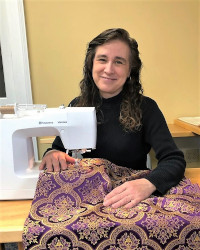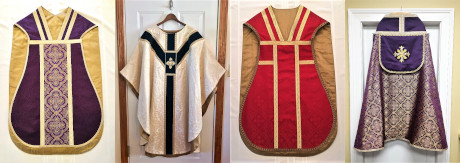- Home
-
About
 Fidelity & Excellence
Fidelity & ExcellenceThomas Aquinas College is unique among American colleges and universities, offering a faithfully Catholic education comprised entirely of the Great Books and classroom discussions.
-
A Liberating Education
 Truth Matters
Truth MattersTruth, and nothing less, sets men free; and because truth is both natural and supernatural, the College’s curriculum aims at both natural and divine wisdom.
-
A Catholic Life
 Under the Light of Faith
Under the Light of FaithThe intellectual tradition and moral teachings of the Catholic Church infuse the whole life of Thomas Aquinas College, illuminating the curriculum and the community alike.
-
Admission & Aid
 Is TAC Right for You?
Is TAC Right for You?Do you enjoy grappling with complex questions? Are you willing to engage in discussions about difficult concepts, with the truth as your ultimate goal?
-
Students & Parents
 Mind, Body & Spirit
Mind, Body & SpiritThere is always something to do at TAC — something worthwhile, something fulfilling, and something geared toward ever-greater spiritual and intellectual growth.
-
Alumni & Careers
 What Can You Do with a Liberal Education?
What Can You Do with a Liberal Education?Nothing speaks more to the versatility of the College’s academic program than the good that our alumni are doing throughout the Church and the world.
- Search
- Giving
Sacred Stitchery: Alumna Sews Priestly Vestments for New England Chapel
“When Father walks among the angels and offers back to God on the altar all our hearts and sacrifices along with his own,” says Hélène (Augros ’92) Froula, “it’s best that he wears something that represents not only the finest of what is available in earthly materials, but also the best kind of offering in terms of human effort.”
For Mrs. Froula, these words reflect not only a pious insight, but also a personal devotion. An alumna of the College, the wife of New England tutor Dr. Josef Froula (’92), and the mother of 10 children, she has personally sewn many of the ornate and beautiful vestments that Chaplain Rev. Greg Markey wears when offering Mass in Our Mother of Perpetual Help Chapel.
This is, she remarks, her small way of aiding the priest in his holy purpose: “Someone’s individual handwork,” she observes, “their precious time and careful attention, which may not be factory-perfect, but perfectly heartfelt and freely given, should be there in support, if possible.”
Of course, it can also be a refreshing change of pace for a busy mother to steal away to her sewing workshop every once in a while. “It’s a very comforting thing,” Mrs. Froula muses, “to know that among the mess and the meatloaf, the undone homework, the upside-down kitchen, and the mountain of laundry, there is a little piece of heaven sitting on the ironing board, quietly waiting for my careful attention whenever I can give it.”
Humble Beginnings
Mrs. Froula vividly remembers her first experience with needle and thread: “My grandmother came for a visit one summer and gave me my first sewing kit. It was an old cigar box of my grandfather’s, lovingly painted and filled with thread, tools, and buttons.” Like any worthy endeavor, sewing wasn’t easy at first. “My grandmother was determined to teach me to embroider,” she recalls. “She started me on a little project which turned out to be a mighty struggle for us both.”
Eventually, the two managed to complete a flowery coverlet. “She showed me how to make many different stitches,” says Mrs. Froula. “But the two most important lessons she taught were that slow work gives the best results, and it’s always OK to take out your stitches and just start over. I am still benefiting from those lessons!”
Small projects around the home were one thing, but Mrs. Froula never imagined that her needlecraft would amount to more than a casual pastime. That changed, however, years ago, when a new associate pastor — “very young, full of energy and optimism” — arrived at what was then the Froulas’ parish. One day, the enthusiastic cleric asked whether she might be willing to sew him a set of vestments. Her first reaction was one of unworthiness: “How could I possibly attempt to make something so fine and noble that he could put it onto his back and march right on into the Holy of Holies with it? Ask me to sew a pillowcase, a shower curtain, a Batman costume. But a real priestly chasuble? No way.”
Resolved nevertheless to try her hardest to fulfill the priest’s request, the determined seamstress hunted through the parish’s sacristy, eventually coming upon an old Gothic vestment which she decided to use as a template for her project. “I made a deep violet Lenten set, and I enjoyed working on it so much that I started making an Easter one as soon as that was done,” Mrs. Froula notes. “Since then I have always had some kind of vestment project for someone going on.”
Yankee Ingenuity
Since acquiring its New England campus — the century-old former site of a Protestant preparatory school — the College has labored to make Our Mother of Perpetual Help Chapel a fitting home for Catholic worship. By sewing some half-dozen vestments, Mrs. Froula has played an important role in that effort. “Having beautiful vestments can serve in a little way, but in an important way, to remind people that God is beautiful,” says student Thomas Aldridge (’23). “There is this eternal beauty which we can always draw close to in the Mass.”
“It is essential that the vestments are beautiful and dignified,” adds Fr. Markey. “As the Book of Hebrews says, the priest is appointed by God, ‘to act on behalf of men in relation to God, to offer gifts and sacrifices for sins’” (Hebrews 5:1). The beauty of the vestments and the Chapel communicate the fact that the Mass is the most important activity that goes on every day on campus.”
Now that she is experienced in the art of sewing vestments, Mrs. Froula heartily recommends it to others, even if they think themselves poorly equipped or insufficiently skilled for such a sacred task. “Sewing vestments is not rocket science,” she assures. “It is actually a fairly simple process and mostly a matter of the design and the gathering of worthy materials. Parishioners who sew can add significantly to the beauty and uniqueness of their sacristy’s collection and save the parish a lot of expense at the same time.”
There is only one downside to this line of work: “Once you have put your whole head, heart, and hands into completing a vestment set, you are probably ruined as a domestic seamstress,” Mrs. Froula laughs. “You will likely never want to sew a boring pillowcase again.”




